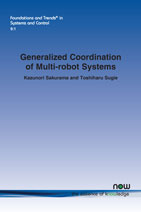Generalized Coordination of Multi-robot Systems
By Kazunori Sakurama, Kyoto University, Japan, sakurama@i.kyoto-u.ac.jp | Toshiharu Sugie, Osaka University, Japan, sugie@jrl.eng.osaka-u.ac.jp
Abstract
Multi-robot systems have huge potential for practical applications, which include sensor networks, area surveillance, environment mapping, and so forth. In many applications, cooperative coordination of the robots plays a central role. There are various types of coordination tasks such as consensus, formation, coverage, and pursuit. Most developments of control methods have been taken place for each task individually so far. The purpose of this monograph is to provide a systematic design method applicable to a wide range of coordination tasks for multi-robot systems. The features of the monograph are two-fold: (i) The coordination problem is described in a unified way instead of handling various problems individually, and (ii) a complete solution to this problem is provided in a compact way by using the tools of “group” and “graph” theories efficiently. As for item (i), it is shown that various coordination tasks can be formulated as a generalized coordination problem, where each robot should converge to some desired configuration set under the given information network topology among robots. In this problem, the solvability (i.e., whether robots can achieve the given coordination task or not) fully depends on the characteristics of both the desired configuration set and the network topology. Therefore, concerning item (ii), it is clarified when the generalized coordination problem can be solved in terms of the desired configuration set and the network topology. Furthermore, it is shown how to design a controller which achieves the given configuration task. In particular, the case where each robot can get only local information (e.g., relative position between two robots) is discussed.
Generalized Coordination of Multi-robot Systems
Multi-robot systems have huge potential for practical applications, which include sensor networks, area surveillance, and environment mapping. In many applications, cooperative coordination of the robots plays a central role. However, there are so many tasks and their variants, it is not viable to describe individually all the existing methods. Instead, in this monograph the authors focus on a generalized coordination problem which can cover a wide range of coordination problems and handle them in a unified manner.
The reader is first introduced to the mathematics and a set of systematic tools that underpin subsequent discussions on the practical implementations. Each chapter in the second part of the book uses the same structure to address three types of generalized coordination problems, namely, Pairwise Coordination; Generalized Coordination with “Absolute” Measurements and Generalized Coordination with “Relative” Measurements. Finally, the authors present real-world applications of generalized coordination.
Throughout, the authors provide examples to clearly illustrate the concepts being discussed. The book provides an accessible overview of the complexities of the topic for students, researchers and practitioners alike.
